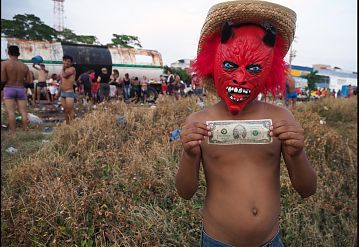Igloo at Dusk, by Bryan Alexander
I took this photograph of Tatigat, an Inuit elder, kneeling at the entrance to an Igloo at dusk in Nunavut, Canada in 1993.
The Igloo is one of the most iconic symbols of the Arctic and Inuit culture. Along with kayak & anorak, it is one of the few Inuit words to have been incorporated into the English language. In English the word “Igloo” is something of a misnomer because in the Inuit language it simply means a “building,” In fact any building, so from an Inuit perspective Buckingham Palace is an Igloo. These small domed-shaped shelters made from blocks of compacted snow that we call an Igloo; the Inuit have a completely different word for. They call them “Igluvijaq.”
When I began photographing Inuit life in the Eastern Canadian Arctic, back in the 1970s, Igloos were still being used by some Inuit as overnight shelters on winter hunting trips. These journeys could last anything from one or two days to several weeks, depending on where the hunters were travelling to, and the prey they were after. On the trips that I joined them on, we would hunt, and sometimes fish, all day, and then before dusk try and find a place with suitable hard packed snow to build an Igloo and spend the night. The following morning, providing the weather was good enough; we would pack up and move on.
Building an igloo was quite a laborious process. It involved cutting snow blocks, usually with a panel saw, then trimming the blocks with a large snow knife and placing them in a spiral, gradually building up the wall area until it was high enough. The final touches involved trimming a snow block for the door at the base of the igloo, and making a very small ventilation chimney called the “Qingaq” (nose) in the roof.
Most of the hunters that I travelled with, particularly the older ones were skilful and could build a small Igloo, large enough for two or three people, in about an hour or so. They would then take inside some caribou skins to sit and sleep on, a small Coleman stove to cook with, a kerosene lamp, and some food.
With a warm sleeping bag, I usually managed to get a reasonably good night’s sleep in an Igloo. The snow bricks provide insulation against the cold. Even when the temperature dipped down below minus 40̊ Celsius at night, it still kept relatively warm inside, just from our body heat and a kerosene lamp. Anyone who has spent a stormy night in a tent knows just how noisy it can get with the wind flapping the tent fabric to and fro. By contrast, inside an Igloo you don’t hear the wind so much. This is partly because the snow bricks insulate you from the sound, but also, the shape of an Igloo allows the wind to pass around it rather than buffeting it. The only comments about noise inside an Igloo that I ever heard, were the remarks of my fellow travellers about how loud my snoring was.
Although the use of Igloos has gradually declined over the years, they remain culturally important to the Inuit. Some communities in the Eastern Canadian Arctic still hold an annual Igloo building competition to help preserve the knowledge and skills involved in their construction. After finishing, each contestant has to stand on the top of their Igloo to demonstrate that it is strong enough and well built.
After studying photography for three years at the London College of Printing, British photographer and writer, Bryan Alexander, used a Royal Society of Arts travel bursary to visit North West Greenland in 1971. There he spent four months photographing life in a small Inuit community. That was the start of what became a lifetime’s work of documenting the Arctic and its peoples. Bryan has spent more than 12 of the past 50 years living in isolated native camps and villages around the circumpolar north.
Bryan has carried out assignments for many of the world's leading magazines including Time, GEO, Le Figaro, Smithsonian, Vogue, People, International Wildlife, and the Sunday Times. His photographs and articles have been published in more than 40 different countries. Bryan has also worked on numerous book projects and has had solo exhibitions of his photographs at a number of prestigious venues including the Royal Geographical Society, London, the Pitt Rivers Museum, Oxford and the Museum of the Arctic & Antarctic, St. Petersburg.
Bryan's ongoing project 'Then & Now' can be seen HERE, and his limited edition book 'Inughuit' can be seen and purchased HERE.
See more work by Bryan Alexander





